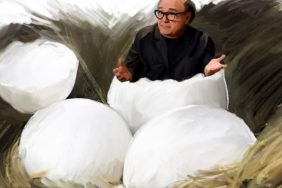Golden Gloves © Sarina Brewer
You may know taxidermy, but rogue taxidermy is its own animal. Think gilded squirrels, two-headed rabbits, a winged magician monkey with a dildo in his hat. These are just a few of the creepy-cute macabre creations of Minneapolis-based artist Sarina Brewer.
The self-proclaimed “science nerd” has always been surrounded by animals and submerged in art. “It runs through our blood,” she says of her artistic lineage. Her great-great uncle worked on the dioramas at the Bell Museum of Natural History and her great-great grandfather was a portrait painter. Her father, a fine artist, and her mother, a graphic designer and book illustrator, met at the Minneapolis College of Art and Design (MCAD). Post-graduation, they moved to a small hobby farm in Green Isle, Minnesota. While they didn’t own livestock, there were plenty of other animals roaming the grounds: chickens, ducks, cats, and dogs.
Even after moving back to the Twin Cities when Brewer was in kindergarten, her mother continued to do wildlife rehab. In the summers, Brewer visited her cousin’s farm in Iowa. It was there, around third grade, that she found a raccoon skull while fossil hunting. “That was when my fascination started with anatomy and biology,” she says. “Everything I have made since can be traced back to this first piece art.”
She later incorporated that skull into a work of art while a student at MCAD. She also used found objects such as rusted metal, tree roots, rocks, bones, and naturally mummified animal remains in her oil paintings and sculptures.

Mother’s Little Helper Monkey © Sarina Brewer
“A lot of my work is with very common animals. There’s nothing super exotic that I work with for that reason. I use what comes my way,” she says. The animals are donated, considered roadkill, or died by natural causes, such as a monkey that perished in a zoo. “Everything is ethically sourced. That’s been the primary directive throughout my artistic career. Nothing is ever killed for my artwork.”
That animals are murdered in the interest of art is one of the big misconceptions about rogue taxidermy, a movement that Brewer spearheaded with two other artists. While Brewer doesn’t know how many artists operate under the rogue taxidermy banner, she says “it has unquestionably become the fastest growing Western art movement and has swept across both North America and Europe in the last decade since its inception.”
A genre of mainstream art, rogue taxidermy artists use glass, metal, paper, ceramics, stone, and/or found objects to create sculptures that incorporate natural elements that sometimes—but not always—include animal parts. Often, an armature is constructed in the shape of the animal. The fur or the hide is placed over the armature and affixed with adhesive or sewing. Rogue taxidermy art can also be made from entirely synthetic materials. Some pieces are abstract and look nothing like the animal from which they were made; others are decorative or conceptual.
Brewer’s creations come in multiple styles: Fantasy (an imaginative spin on folklore or mythology), Carnival Curiosa (freak show-worthy creatures), Designer (i.e. high-end stuffed animals), Gilded Grotesques (aforementioned gold leafing), and Esodermy (think “Body Worlds,” but with preserved critter carcasses). Brewer’s work is so fabulously freaky, it garnered the attention of the New York Times art section in 2005.

Initially, Brewer received hate mail but took in stride. “When I graduated from MCAD my work was very controversial for its time,” she says. “I always found it interesting that I was a target. People don’t think twice when they put on a pair of leather shoes or eat a hamburger. Animals were killed for those things, yet people had a problem with art made out of animal materials that were being recycled. That pretty much sums up the intelligence level of the ‘haters’ I once had to deal with. People are fearful of things they don’t understand.”
Brewer, who has volunteered intermittently at the biology department of the Science Museum of Minnesota over the past ten years, says even that institution has received hate mail—from people offended by a mummy. “People have their own opinions about what they consider respectful to do with a deceased person or animal. People who don’t agree voice negative opinions sometimes,” she says. “It’s as contagious as it is controversial at this point.”
Showing her work on the gallery scene has helped neutralize the conflict. “Whatever’s in an art gallery becomes the ‘hot thing’ and is assimilated into popular culture,” she says. In the early days, her buyers were often tattoo artists who wanted something unusual for their parlors. Now she works with galleries, sells one-of-a-kind pieces off her website, and does a substantial amount of custom work. One of her most noteworthy buyers is Nike CEO Mark Parker, who purchased a piece for his infamous art collection. Brewer’s creatures are also in the Geneva Museum of National History in Switzerland.
Whether you covet Brewer’s critters or are terrified by them, don’t call her a taxidermist. “For me to call myself a taxidermist would be like calling myself a mechanic because I can change the oil in my car,” she says. “Taxidermy is not what I do for a living. I have a BFA. That’s the way I look at my work: it’s sculpture.”
Brewer is an artist through and through, and the taxidermied animals are her medium, not unlike how a sculptor requires clay or a painter needs paint to manifest creative expression.
“As a society we are always asking ‘What defines art?’, ‘Can art still be shocking?’, and ‘Can anything new be done that hasn’t been done already?’ Rogue Taxidermy pushes all three boundaries, which is why it’s so provocative and generates so much discussion.”








